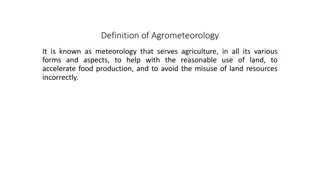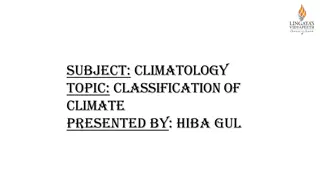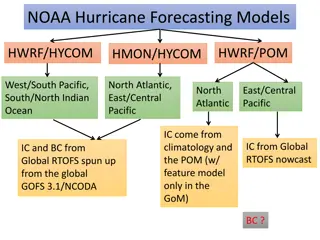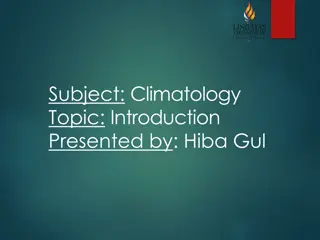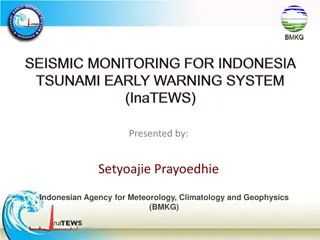Understanding Physical Climatology and Agrometeorology
Exploring the relationship between physical climatology and agrometeorology, this branch of meteorology delves into the effects of weather and climate on agriculture. Through studying processes occurring from soil depths to atmospheric levels, agricultural meteorologists play a crucial role in ensuring the sustainability of agriculture by providing valuable climate information and assisting in decision-making to mitigate harmful effects and adapt to climate variability and change.
Download Presentation

Please find below an Image/Link to download the presentation.
The content on the website is provided AS IS for your information and personal use only. It may not be sold, licensed, or shared on other websites without obtaining consent from the author. Download presentation by click this link. If you encounter any issues during the download, it is possible that the publisher has removed the file from their server.
E N D
Presentation Transcript
PHYSICAL CLIMATOLOGY AND AGROMETEOROLOGY DR.IQBAL KHALAF
PHYSICAL CLIMATOLOGY AND AGROMETEOROLOGY PHYSICAL CLIMATOLOGY AND AGROMETEOROLOGY - 1 The relation between physical climatology and Agrometeorology and their effects A branch of meteorology that examines the effects and impacts of weather and climate on crops, rangeland, livestock, and various agricultural operations. The branch of agricultural meteorology dealing with atmospheric-biosphere processes occurring at small spatial scales and over relatively short time periods is known as micrometeorology sometimes called crop micrometeorology for managed vegetative ecosystems and animal biometeorology for livestock operations Agricultural climate science is the branch that studies the processes and effects of climate factors on a larger time and spatial scale Agricultural meteorology, or agrometeorology, addresses topics that often require an understanding of biological, physical, and social sciences.
It studies processes that occur from the soil depths where the deepest plant roots grow to the atmospheric levels where seeds, spores, pollen, and insects may be found. Agricultural meteorologists characteristically interact with scientists from many disciplines. Agricultural meteorologists collect and interpret weather and climate data needed to understand the interactions between vegetation and animals and their atmospheric environments Climate information developed by agricultural meteorologists is valuable in making sound decisions, including: 1- Management of resources consumed by agriculture. 2- improving agricultural production. 3- adopting agricultural practices to reduce any harmful effects of agriculture on the environment
Such information is vital to ensure the economic and environmental sustainability of agriculture now and in the future. Agricultural meteorologists also quantify, evaluate, and provide information on the impact and consequences of climate variability and change on agriculture. Increasingly, agricultural meteorologists assist policy makers in developing strategies to deal with - : - 1 climatic events such as floods, hail, or droughts - 2 climatic changes such as global warming and climate variability. Agricultural meteorologists are involved in many aspects of agriculture, ranging from the production of agronomic and horticultural crops, trees, and livestock to the final delivery of agricultural products to market
They study the energy and mass exchange processes of heat, carbon dioxide, water vapor, and trace gases such as methane, nitrous oxide, and ammonia, within the biosphere on spatial scales ranging from a leaf to a watershed and even to a continent. They study, for example, the photosynthesis, productivity, and water use of individual leaves, whole plants, and fields. They also examine climatic processes at time scales ranging from less than a second to more than a decade.
Some important terms Agricultural Climatology In general, the study of climate as to its effect on crops; it includes, for example, the relation of growth rate and crop yields to the various climatic factors and hence the optimum and limiting climates for any given crop. Also known as agroclimatology. Biometeorology A branch of meteorology and ecology that deals with the effects of weather and climate on plants, animals, and humans. The principal problem for living organisms is maintaining an acceptable thermal equilibrium with their environment. Organisms have natural techniques for adapting to adverse conditions. These techniques include acclimatization, dormancy, and hibernation, or in some cases an organism can move to a more favorable environment or microenvironment. Humans often establish a favorable environment through the use of technology.
Climatology The scientific study of climate. Climate is the expected mean and variability of the weather conditions for a particular location, season, and time of day. The climate is often described in terms of the mean values of meteorological variables such as temperature, precipitation, wind, humidity, and cloud cover. A complete description also includes the variability of these quantities, and their extreme values. The climate of a region often has regular seasonal and diurnal variations, with the climate for January being very different from that for July at most locations. Climate also exhibits significant year-to-year variability and longer-term changes on both a regional and global basis.
The goals of climatology are to - 1 provide a comprehensive description of the Earth s climate over the range of geographic scales, - 2 understand its features in terms of fundamental physical principles - 3 develop models of the Earth s climate for sensitivity studies and for the prediction of future changes that may result from natural and human causes.









